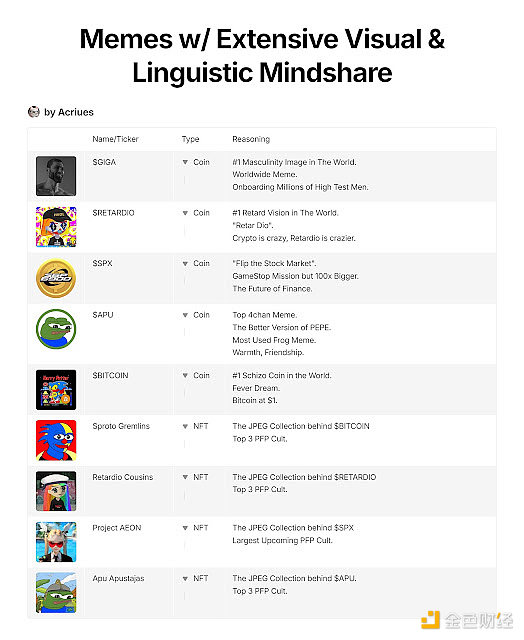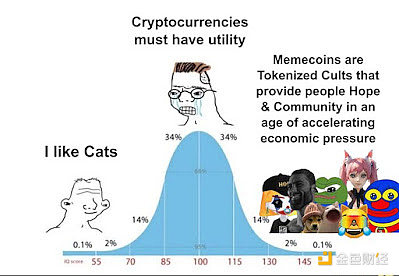By JP Koning, Moneyness
Compiled by: 0xjs, Golden Finance
Cypherpunks wanted to change the world. But we ended up creating memecoin.
Our story begins with some very smart and idealistic developers, known as cypherpunks, who created a new technology, the blockchain. Blockchains are databases, but decentralized. They are advertised as "uncensorable," making it less likely that users will be interfered with by third parties.
Cypherpunks have long hoped that their tamper-proof databases would flourish, go mainstream and improve the lives of ordinary people. A 2015 video shot from interconnected power plants, grocery stores, hospitals and airplanes then arrogantly declared that Ethereum, one of today’s largest blockchains, would become “the security backbone for everything from e-commerce to the internet of things.”
Some of you may remember another famous video from the mid-2010s, in which young Ethereum co-founder Vitalik Buterin challenged his audience: “What would you build on top of Ethereum?” The world responded. Forget connected power plants and grocery stores. The most popular thing built on top of the blockchain was memecoins.
Memecoins are a pure form of gambling. These worthless tokens are usually created anonymously and usually have a mascot or mee loosely associated with them, some famous examples are dogecoin, pepe, HarryPotterObamaSonic10Inu, gigachad, and dogwifhat. Memecoins do not provide dividends and do not bring any productive activity. Its price depends entirely on subsequent players buying it back at a higher price. The result is a highly volatile pyramid gambling game.

Memecoins don’t exactly align with the cypherpunks’ dream of creating a fairer system where everything, including all of high finance (by which I mean banking, payments, insurance, and investing), has migrated to blockchain heaven. Memecoins are the epitome of low finance. They belong in the same ghetto as some of the seediest members of the financial world: lotteries, slot machines, chain letters, sweepstakes, high-yield investment programs, and other zero-sum games.
Cypherpunks and their ilk are disgusted by memecoins. They want their blockchain to be used for higher causes:
- It’s sucking the energy out of cryptocurrencies
- This is a complete fabrication, a complete mockery, a clown show
- In 2024, things hit rock bottom: racist, sexist, and otherwise stupid memecoins are just a tool to transfer wealth from the majority to the most annoying people on the planet
- Besides undermining the long-term vision of cryptocurrencies that keeps many people in the space, memecoins don’t make a lot of sense technically.
Vitalik also complained that “even non-racist memecoin prices often just go up and down without adding any value.” In an attempt to find a silver lining, he implored memecoin makers to donate part of their supply to charity, much like raffles are used to fund charities.
Cypherpunks’ frustration with memecoins is understandable. But I don’t think cypherpunks should be complaining. What on earth do you think your zero-rule financial infrastructure will be used for, guys?! Memecoins are the point.
Memecoins as the basic unit of blockchain
People naturally love gambling, but gambling has a bad reputation and many gambling games have been declared illegal. Memecoins are a good example, and they have been banned from society’s official financial venues, including its stock exchanges and commodity markets, as well as its casinos and online gambling sites.
In Canada, historically a haven for shady finance, the closest you can get to issuing memecoins is to go the junior gold route. Start a gold exploration company, buy the title to some worthless property in a remote part of northern Canada, list the company on a junior stock exchange, promote your scam as the next big gold mine, and sell it to latecomers. You’ve basically created a memecoin; a token with no basis.
But this is the hard way to run a memecoin. You still have to pretend to be a regular company, publish audited financial statements, and hire a board of directors, plus you have to give your real name, which means potential lawsuits or criminal charges. A pure memecoin like dogwifhat, unburdened by any of these expensive real-world obligations, would never get a listing, even on Canada’s most shady junior stock exchange.
Enter blockchain, which is inherently anarchic. Blockchain allows people to deploy illegal and unregulated gambling games without the authorities being able to step in and say, “Hey, you can’t do that.” With mainstream exchanges and casinos closed to them, it’s no wonder memecoins are dominating new media.
If your blockchain doesn't have a constant flow of memecoin issuance, it's effectively dead. A throng of crazed gamblers buying and selling meaningless, unproductive currencies marks a thriving and fertile, censorship-resistant financial medium.

As for the cypherpunk idealists who complain about memecoins, they should swallow their pride and accept that blockchains will probably never be the “backbone of everything.” Instead, blockchains will continue to serve as the main hub for seedy low-level finance; things like memecoins and Ponzi schemes simply won’t make it onto the official scene. Many low-level financial services will be illegal, dubious, or offensive, because those are the kinds of things that need to be censorship-resistant. (To be fair, some of the banned low-level financial services are pretty useful.)
Memecoins are sometimes described as a potential gateway drug or Trojan horse for wider blockchain adoption. “Once they try dogwifhat, they can’t resist my quadratic voting project.” But this is just wishful thinking. Serious and respectable advanced financial services like insurance and banking — things we all need in our daily lives — must necessarily be legal and therefore welcome in a mainstream environment, so these services and their users will never need to be sucked into the rule-less ground floor like memecoins have been.
What would you build on the blockchain? Memecoins. They are the basic financial unit of cryptocurrency.















